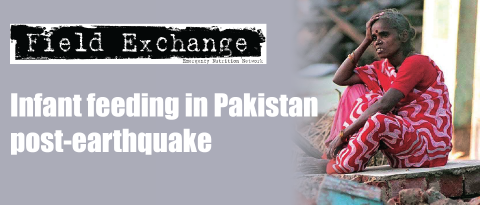Issue 27 Editorial
Every emergency has a habit of throwing up fresh challenges which force us to re-examine our understanding of vulnerability and how best to respond. However, as shown in this issue of Field Exchange, our success in adapting and responding effectively to 'new' situations and conditions of vulnerability is variable. This highlights the fundamental importance of getting vulnerability analysis right. At the same time there appears to be no let up in our quest to improve our 'programming techniques'. All the field articles in this issue have lessons for improved programming and provide examples of innovative practice and thinking.
A WFP evaluation of the tsunami response in Sir Lanka and Indonesia found that although more women than men were killed and injured during the tidal wave and that they were the most vulnerable after the disaster, the response did not always cater adequately for their needs. Much of the response centred on supporting income generation activities, especially amongst men, while rehousing was given less priority leaving women and children in often overcrowded IDP settlements. A key reason for this was that women were excluded from the decision-making process. In a similar vein, HelpAge found that the tsunami response missed out on the specific needs of the elderly who were also particularly affected by the disaster. The elderly were often poorly served in chaotic distributions while food rations failed to take account of their chronic health problems including high blood pressure, diabetes, cancer, etc.
The impact of climate change on vulnerability is now beginning to register on the radar of the humanitarian sector. A special issue of the IDS bulletin (summarised in the research section) contains a series of cases showing adaptation to the impact of climate change, which is gradually altering the nature of vulnerability for different livelihood groups. Examples include community adaptation to repeated floods and droughts in Bangladesh and Rajasthan, agricultural intensification in Senegal, climate proofing and diversifying livelihoods in Zimbabwe and benefiting from global warming in Zimbabwe. In some cases, adaptive responses are working while in others they are not. A key conclusion of the work is that vulnerability analysis in relation to adaptations to climate change should be incorporated systematically into policy and institutional frameworks for development and disaster relief.
An excellent example of how vulnerability analysis can inform best practice in crisis is seen in the Tufts university study on the impact of the conflict on livelihoods in Darfur (research section). Here, vulnerability and its causes is analysed at the micro and macro level in terms of governance, discrimination against ethnic groups, access to services and impact of the conflict on remittances and pastoral systems. The wide ranging analysis leads to an equally wide set of multi-sectoral recommendations that, if implemented, will have far greater impact than standard food aid responses.
Field articles in this issue of Field Exchange demonstrate an encouraging capacity for critiquing programme approaches and finding creative solutions. Taken together, the articles show that agencies are most definitely not prepared to sit on their laurels.
An article by Jason Stobbs describes the experience of using the centric sampling system in Uvira, Zaire in order to improve the accuracy of programme coverage data. Such data are often derived from nutrition surveys and are may be intrinsically flawed by virtue of the type of sampling adopted. Both the strengths and weaknesses of the relatively new centric sampling approach are clearly demonstrated by the authors. A second article (by Johannah Wegerdt, Monica Zanchettin and Mark Myatt) describes the use of the 'capture/ recapture' method for assessing population size. Accurate census data are notoriously difficult to obtain in emergency contexts so that any new and improved means of acquiring such data has to be a good thing. Assumptions and difficulties of the capture/recapture method are spelt out based on case study experience. In another article, ACF describe their innovative use of GIS in Mali to better understand vulnerability of pastoral systems. Kara Greenblott from C-Safe, a consortium of INGOs based in the southern Africa region, has written an article describing experiences of applying exit strategies to food aid programming in Lesotho, Zambia and Zimbabwe. Reflecting the thinking of C-Safe members she concludes that exit strategies should not just be seen as a way of 'getting out' of long-term commitments but rather as a means of leaving sustainable programmes. The final field article is written by Tayech Yimer, Anne Marie Mayer and Arabella Duffield from SC UK and describes the difficulties of impact assessment based on experience of the RDIR programme in Ethiopia. The authors clearly set out the methodological challenges of impact assessment while at the same time proposing a number of technical and institutional solutions.
Finally, and very much in keeping with the theme of 'critiquing what we do in order to implement better programmes', the ENN and SC UK have begun a review of the effectiveness of emergency SFPs (see research section) with a view to determining whether this standard nutritional emergency response is always the most appropriate and effective means of dealing with mild and moderate malnutrition. The review involves at least 14 INGOs/UN agencies who are expected to provide data sets from over 150 emergency SFPs conducted during the past four years. The methodology for this study, which is still in its early stages, is set out in the research section. Watch this space for the study findings.
Jeremy Shoham, Editor
Any contributions, ideas or topics for future issues of Field Exchange? Contact the editorial team on email: office@ennonline.net
Imported from FEX website


